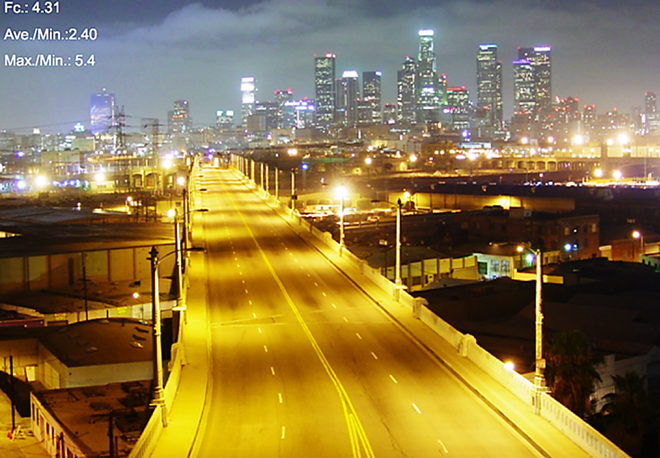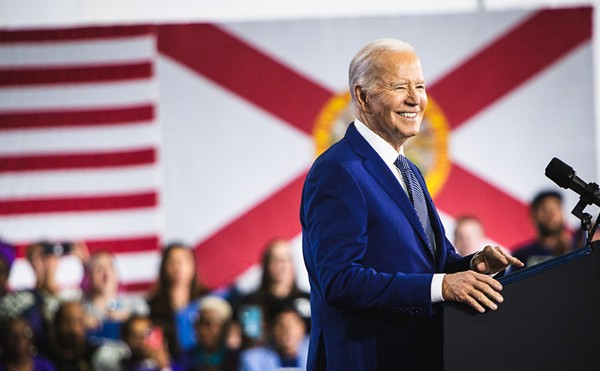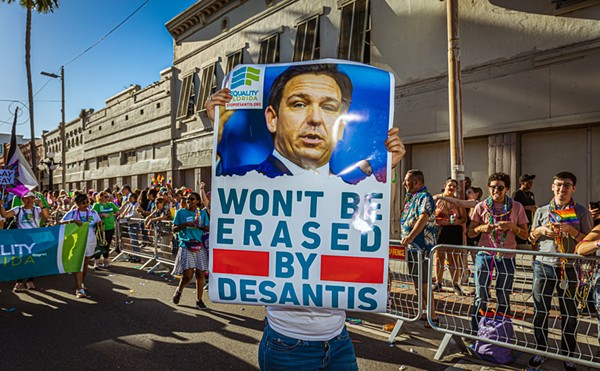
Let there be lights.
That was the welcome message delivered last year by Mayor Bob Buckhorn to a smiling group assembled outside the New Hope Missionary Baptist Church in East Tampa.
Flanked by representatives from Tampa Electric Company — the city’s sole power company and one of the most powerful corporations in the Bay area — the mayor announced that 8,400 new streetlights would be installed by TECO at a cost to the city of $2.2 million over the next five years in areas where they are most needed, particularly East Tampa, Ybor City and Sulphur Springs.
Councilman Frank Reddick, who represents a good portion of those areas, says streetlight improvements have been among his constituents’ top concerns — especially since the incident a year ago when a pregnant 27-year-old woman named Monica Alvarez was struck and killed by a motorist as she and a friend were pushing their babies in strollers down a darkened street, a street where TECO soon installed a streetlight.
But some critics are questioning why a city led by a mayor and City Council who pride themselves on being all about sustainability are opting to light up the city with antiquated lighting technology — technology that local environmentalist Susan Glickman calls the equivalent of an 8-track cassette tape.
A better, more efficient alternative, says Glickman, would be to use LED, or light-emitting diode, technology. But Tampa and other Florida cities remain in the dark ages where lighting innovation is concerned — at least for now.
Most streetlights are owned by local utilities: TECO in Tampa and Progress Energy in St. Petersburg and Clearwater (Progress has merged with North Carolina-based Duke Energy and will soon change its name). The cities pay the utilities for the cost of installation and the electricity used.
So if Tampa wants its new lights to be LEDs, the city needs to get TECO to agree. But Tampa Electric has until recently been uninterested in providing such lights. Too expensive, TECO has claimed, so the utility has not even taken the necessary first step — applying to the Public Service Commission in Tallahassee to get a tariff, or an approved rate, for LED lights.
So what’s so special about LEDs?
Conventional lighting (which in Tampa means light bulbs made of high-pressure sodium and metal halide) tends to decay in quality over time and have a shorter life when dimmed.
Light-emitting diode technology not only uses less energy than conventional methods, it also provides highly directional light, shining only on the spot that needs illumination, reducing light pollution.
According to a report called Lighting the Clean Revolution by The Climate Group, energy savings from LED technologies range between 50-70 percent compared with conventional alternatives. LEDs are also better for the environment. Their only major negative right now is the up-front costs. But prices have been dropping in the past few years, and advocates say whatever funds are expended up front are more than made up for on the back end.
And quality of light can have a direct influence on quality of life, improving both a city’s aesthetics and safety levels. In before-and-after photos taken of roadways around the country, the changes wrought by LED illumination seem almost literally like night and day. In Baltimore, where some 80,000 streetlights are being retrofitted to LEDs, City Councilman Robert Curran says, “When you compare these two types of lighting directly, the difference is stark.”
Los Angeles, which unlike Tampa or St. Petersburg owns its public utility, is using direct borrowing to finance the largest LED street lighting project in the U.S., retrofitting 140,000 lights. When the plan was announced in February of 2009, it was estimated that once the lights are fully converted in 2014, the city will save a minimum of 40 percent on lighting costs and reduce carbon emissions by approximately 40,500 tons a year. The city has reported a 10.5 percent reduction in crime incidents between 7 p.m. to 7 a.m. since LED lights were installed.
Seattle has also been a trendsetter, working since 2007 to convert all 41,000 of its streetlights to LED by 2014. And in Charlotte, a city with which Tampa frequently likes to compare itself, the City Council has approved $179,000 for the purchase and installation of LED streetlights. The city made an upfront single payment to Duke Energy, which said in return it would cut the city’s monthly fee for those lights by $7.50 a pole.
St. Petersburg City Councilman Karl Nurse wants his city to jump on the LED bandwagon.
At an energy summit hosted by Agriculture Secretary Adam Putnam at St. Petersburg College’s Seminole campus in August, Nurse told Putnam the state could save millions of dollars annually through the conversion to LED streetlights.
He followed up in a letter to Patrick Sheehan, director of the Florida Energy Office, which is under the aegis of Agriculture. Nurse also advised the city’s St. Public Works Administrator, Mike Connors, to contact officials there.
















